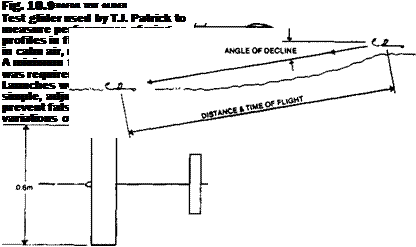FLIGHT TESTING
With all its disadvantages, the wind tunnel remains the easiest and most accurate method of testing wings and other aircraft components under standard conditions. Model fliers rightly regard such results as slightly doubtful, since the aerial conditions in which their aircraft fly are never as consistent as those of the laboratory. For instance, with all the effort put into reducing turbulence in wind tunnels, it is still not known what the turbulence’ of the air of the ordinary atmosphere is when the model is flying at different altitudes, different temperatures and in conditions of varying humidity, etc. The final test is always in real flight and even full-sized aircraft sometimes surprise their designers after years of preliminary studies and tunnel tests.
 |
Some model fliers, such as V. Seredinsky and T. J. Patrick, have attempted to test model wing sections by gliding small, specially constructed free flight models in calm conditions from the tops of hills. Useful results can be obtained in this way although there is a good deal of statistical ‘scatter’ in the figures. Such test methods are at the mercy of the weather. The models tend to wander off course, rendering exact timing and distance measurements very difficult. Indoor tests of the same kind rarely produce usable results because the distance available for the glide is too short to allow the model to settle to a constant airspeed. (See Figure 10.9)
With radio control, much more is possible and some preliminary testing has been done by a group in California, as reported by B. K. Rawdon. On occasions of true calm, gliding models can be timed at various trims over a series of long glides, with altitudes measured by photography and various triangulation techniques. Statistical scatter is still a problem but useful Figures have been found in this way.
There is a great deal of scope for refined instrumentation of large model aircraft. A model may be equipped with sensitive electronic devices to measure altitude and flight speed, angle of attack, and even air turbulence. The wing may be Fitted with pressure tapping perforations, just as wind tunnel models are, and wake rakes may be used. The data found in these ways may be recorded, either in die model itself or transmitted to the ground for immediate plotting. At the time of writing, no such results have been published,
although work along such lines is proceeding in a few places and research into remotely piloted military surveillance aircraft (effectively, large, long range model aeroplanes) is proceeding in many places. The future should produce some extremely important discoveries.














